UMass Extension's Landscape Message is an educational newsletter intended to inform and guide Massachusetts Green Industry professionals in the management of our collective landscape. Detailed reports from scouts and Extension specialists on growing conditions, pest activity, and cultural practices for the management of woody ornamentals, trees, and turf are regular features. The following issue has been updated to provide timely management information and the latest regional news and environmental data.
Thanks for your continuing interest! Note that we are now in the every-other-week period of the season, and the next message will be posted on August 11. To receive immediate notification when the next Landscape Message update is posted, be sure to join our e-mail list
To read individual sections of the message, click on the section headings below to expand the content:
Scouting Information by Region
Environmental Data
The following data was collected on or about July 26, 2023. Total accumulated growing degree days (GDD) represent the heating units above a 50ºF baseline temperature collected via regional NEWA stations (http://newa.cornell.edu) for the 2023 calendar year. This information is intended for use as a guide for monitoring the developmental stages of pests in your location and planning management strategies accordingly.
|
MA Region/Location |
2023 Growing Degree Days |
Soil Temp |
Precipitation |
Time/Date of Readings |
||
| Gain since last report |
2023 total |
Sun |
Shade |
|||
|
CAPE |
351 |
1339 |
77 |
71 |
0.51 |
7/26/2023 12:00 PM |
|
SOUTHEAST |
360 |
1368 |
84 |
73 |
4.28 |
7/26/2023 3:00 PM |
|
NORTH SHORE |
335 |
1267 |
71 |
67 |
1.94 |
7/26/2023 9:30 AM |
|
EAST |
362 |
1483 |
76 |
72 |
4.27 |
7/26/2023 4:00 PM |
|
METRO |
333 |
1370 |
68 |
66 |
1.71 |
7/26/23 5:45 AM |
|
CENTRAL |
338 |
1432 |
71 |
69 |
5.71 |
7/26/2023 3:30 PM |
|
PIONEER VALLEY |
338 |
1484 |
76 |
70 |
8.40 |
7/25/2023 12:30 PM |
|
BERKSHIRES |
299 |
1225 |
73 |
67 |
5.10 |
7/26/2023 6:15 AM |
|
AVERAGE |
340 |
1371 |
75 |
69 |
3.99 |
- |
|
n/a = information not available |
||||||
US Drought Monitor: Persistent rainfall continues to keep drought conditions at bay; there are no drought areas currently designated in the state of Massachusetts. State map as of Thursday 7/27: https://droughtmonitor.unl.edu/CurrentMap/StateDroughtMonitor.aspx?MA
Phenology
| Indicator Plants - Stages of Flowering (BEGIN, BEGIN/FULL, FULL, FULL/END, END) | ||||||||
|---|---|---|---|---|---|---|---|---|
| PLANT NAME (Botanic / Common) | CAPE | S.E. | N.S. | EAST | METRO W. | CENT. | P.V. | BERK. |
| Polygonum cuspidatum / Reynoutria japonica / Fallopia japonica (Japanese knotweed) |
* | Begin/Full | * | * | * | * | Begin | * |
| Clethra alnifolia (summersweet clethra) | Begin | * | * | Begin | Begin | Begin/Full | Full | * |
| Hibiscus syriacus (rose-of-Sharon) | Begin/Full | Full | Full | Full | Full | Full | Full | * |
| Buddleia davidii (butterfly bush) | Begin/Full | Full | Full | Full | Full | Full | Full | Begin |
| Campsis radicans (trumpet vine) | Full/End | Full | Full | Full | Full | Full | Full | Begin/Full |
| Hydrangea paniculata (panicle hydrangea) | Full | Full | Full | Full | Full | Full | Begin/Full | Begin/Full |
| Lythrum salicaria (loosestrife) | Full | Full/End | * | Full | * | Full | * | * |
| * = no activity to report/information not available | ||||||||
Regional Notes
Cape Cod Region (Barnstable)
General Conditions:
The average temperature for the period from July 12 to July 26 was 75℉ with a high of 89℉ on July 12 and a low of 62 on July 21. The period began with fairly muggy conditions with high dewpoints and warm nights above 70℉; the last week or so has had slightly cooler nights in the 60s and lower dewpoints. There has been a mix of cloudy and sunny days during the period. Precipitation totals for the period were just over half an inch, with most of the precipitation occurring on July 14 & 16. No precipitation has occurred over the last eight days, causing soil moisture to become short and irrigation is likely needed again in some landscapes.
Herbaceous plants seen in bloom during the period include daylily (Hemerocallis spp.), hosta (Hosta spp.), purple coneflower (Echinacea purpurea), shasta daisy (Leucanthemum x superbum), and black eyed Susan (Rudbeckia hirta). Woody plants seen in bloom include some sporadic bloom on rhododendron (likely a response to increased soil moisture), sourwood (Oxydendrum arboreum), mimosa (Albizia julibrissin), and hydrangeas (H. macrophylla, H. paniculata, H. quercifolia, and H. arborescens).
Pests/Problems:
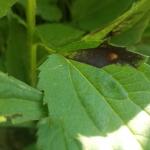
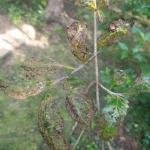
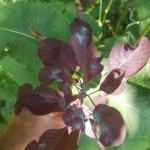
 Insects or insect damage observed during the period include Japanese, Oriental and Asiatic beetle adults feeding on various ornamentals, turpentine beetle on pitch pine, pine tip moth damage on pitch pine, hibiscus sawfly on hardy hibiscus, sawfly larvae on tupelo (black gum leafslug sawfly?), yellownecked caterpillar feeding on blueberry, daylily leafminer damage on daylily, and rudbeckia psyllid on rudbeckia.
Insects or insect damage observed during the period include Japanese, Oriental and Asiatic beetle adults feeding on various ornamentals, turpentine beetle on pitch pine, pine tip moth damage on pitch pine, hibiscus sawfly on hardy hibiscus, sawfly larvae on tupelo (black gum leafslug sawfly?), yellownecked caterpillar feeding on blueberry, daylily leafminer damage on daylily, and rudbeckia psyllid on rudbeckia.
Disease symptoms or signs observed during the period include foliar nematodes on hosta, beech leaf disease on American beech, maple anthracnose on red maple, oak anthracnose on white oak, apple scab and cedar apple rust on crabapple, and powdery mildew on various herbaceous and woody species.
Rabbits are abundant.
Weeds in bloom include cats ear (Hypochaeris radicata), fleabane (Erigeron annuus), sheep’s bit (Jasione montana), common tansy (Tanectum vulgare), redroot pigweed (Amaranthus retroflexus), lambsquarters (Chenopodium album), Pennsylvania smartweed (Polygonum pensylvanicum), and knapweed (Centaurea maculosa).
Southeast Region (Dighton)
General Conditions:
The past two weeks of July have been hot and humid with heavy rains in the first week, not so much in the second. Total rainfall was a merciful 4.28 inches. Monday the 17th saw a high of 87°F. The low was 62°F the morning of the following Monday, July 24th. The average temperature for the period was 68°F. The highest winds were 20 mph on Sunday the 16th.
Plants in flower: Buddleia davidii (butterfly bush), Campsis radicans (trumpet vine), Hibiscus syriacus (rose-of-Sharon), Hydrangea paniculata (panicle hydrangea), Koelreuteria paniculata (golden rain tree), Lythrum salicaria (purple loosestrife), and Reynoutria japonica (Japanese knotweed)
Spicebush swallowtails, eastern tiger swallowtails, painted ladies, monarchs, silver-spotted skipper butterflies, hummingbird moths, bee flies, blue mud daubers, and golden digger wasps are daytime visitors in flower gardens.
Pests/Problems
Adults of Asiatic garden beetle and Japanese beetle have been observed. Slugs and snails are taking full advantage of high humidity, even feeding during the day on herbaceous foliage.
North Shore (Beverly)
General Conditions:
This reporting period was hot and humid. Daytime temperatures were in the low to mid 80s and night time temperatures ranged from the low 60s to low 70s. The average daily temperature was 74℉. The average daily maximum temperature was 81°F and the daily minimum temperature was 66℉ with the maximum temperature of 86℉ recorded on July 17 and the minimum temperature of 62℉ recorded on several nights during this period. On a few days we had rain showers that has enabled garden plants and lawns to remain green and fresh. Approximately 1.94 inches of rainfall were recorded at Long Hill. Woody plants seen in bloom include: oakleaf hydrangea (Hydrangea quercifolia), smooth leaf hydrangea (Hydrangea arborescens), panicle hydrangea (Hydrangea paniculata), summer blooming spirea (Spiraea japonica), false spirea (Sorbaria sorbifolia), mountain stewartia (Stewartia ovata), cut-leaf chaste tree (Vitex negundo), golden rain tree (Koelreuteria paniculata), bottlebrush buckeye (Aesculus parviflora), trumpet vine (Campsis radicans), and sourwood (Oxydendrum arboreum). Herbaceous plants seen in bloom include: black-eyed Susan (Rudbeckia hirta), purple coneflower (Echinacea purpurea), bush cinquefoil (Potentilla fruticans), cranesbill (Geranium spp.), bee balm (Monarda spp.), Turk's cap lily (Lilium superbum), milkweed (Asclepias spp.), montbretia (Crocosmia x crocosmiiflora), shasta daisy (Leucanthemum x superbum), yarrow (Achillea millefolium), hostas (Hosta spp.), sedums (Sedum spp.), lamb’s ear (Stachys officinalis), tall meadow rue (Thalictrum rochebrunianum), false goat’s beard (Astilbe spp.), summer flowering roses (Rosa spp.), water lily (Nymphaea odorata), and an assortment of annual plants.
Pests/Problems:
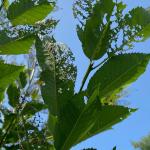 Powdery mildew on lilac, bee balm and phlox. Japanese beetle damage was observed on some plants. Rabbits are plentiful this year and causing damage to some perennial and vegetable plants. Crabgrass, yellow nutsedge, and other weeds are thriving due to the hot temperatures and precipitation. Ticks and mosquitos are very active. Protect yourself with an effective insect repellent before going out to the woods and check your body for ticks after you return.
Powdery mildew on lilac, bee balm and phlox. Japanese beetle damage was observed on some plants. Rabbits are plentiful this year and causing damage to some perennial and vegetable plants. Crabgrass, yellow nutsedge, and other weeds are thriving due to the hot temperatures and precipitation. Ticks and mosquitos are very active. Protect yourself with an effective insect repellent before going out to the woods and check your body for ticks after you return.
East (Boston)
General Conditions:
We have had mainly hot and humid weather over the past two weeks. Daytime temperatures averaged 85℉ with a high of 91℉ back on July 12th. Overnight lows averaged 67℉ with a four day stretch from July 15th through the 18th when overnight temperatures never fell below 70℉. We received significant precipitation over this two week period in three rain events; July 16th, 21st and 25th with each delivering over an inch of rain, totaling 4.27 inches. Most plants are enjoying the influx of precipitation and heat. Plants in bloom include; Aesculus parviflora (bottlebrush buckeye), Hibiscus moscheutos (swamp mallow), Hydrangea paniculata (panicle hydrangea), and Oxydendrum arboreum (sourwood).
Pests/Problems:
Current conditions have been conducive to fungal activity throughout the landscape. Cercospora leaf spot has been observed on Stewartia japonica. There has also been an abundance of insect activity. Hibiscus sawfly larvae (Atomacera decepta) have been defoliating hardy hibiscus. Hydrangea scale (Pulvinaria hydrangeae) has been active on climbing hydrangea. Japanese beetle adults (Popillia japonica) have been observed in large numbers feeding on herbaceous plants as well as the foliage of trees and shrubs. Mugwort (Artemisia vulgaris) is flowering along roadsides.
Metro West (Acton)
General Conditions:
If I had to use two adjectives to describe the weather for this past two-week reporting period, I would use wet and humid. Some amount of precipitation was recorded on 11 of the 14 days. Most of the rain came in the form of downpours and fast-moving storms including a tornado warning on Sunday the 16th at approximately 8:00 AM. There was no tornado, but 0.55” of rain was recorded. The historical monthly average rainfall for the month of July is 3.43” and as of the 25th, 5.35” of rain has been recorded so far this month. We have yet to experience a heat wave and have only recorded one day this month, on the 6th, with a temperature recorded in the 90s.
Pests/Problems:
Setting seed and quite visible is Ailanthus altissima (tree of heaven), an invasive tree that is now highly visible and showy because its seeds (samaras) are reddish in color, are plentiful, and grow in large clusters. Look for it growing along roadsides and in parking lots and medians. Observed in the landscape these past two weeks were leaf blotch on Aesculus spp. (horsechestnut), cedar apple rust on Amelanchier spp. (serviceberry) and Crataegus spp. (hawthorn), anthracnose on Cornus sp. (dogwood), and powdery mildew on Monarda spp. (bee-balm), Paeonia spp. (peony), Phlox spp., and Syringa spp. (lilac).
Central Region (Boylston)
General Conditions:
During this reporting period in central Massachusetts, the weather has been hot and humid, punctuated by thunderstorms and heavy, torrential rains. We’ve seen a warming trend, with maximum daily temperatures steadily rising, peaking in the last couple of days at 88.1℉. The average daily temperatures fluctuated from the low to high 70s. Total precipitation was 5.17” for this period. The recent storms have caused considerable washout on our trails and other types of erosion. On the other hand, the plants in our gardens love this weather and they’ve been growing rapidly. This is true for weeds, too. As such, weed pressure has been very high this month. Overall, the weather has been hot, humid, and unusually wet.
Pests/Problems:
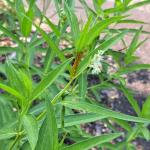
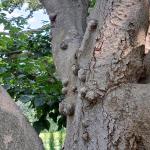 As far as pests go, Aphis nerii (Oleander aphid) has been observed on various Ascelpias spp. (milkweed) in the gardens. Chrysomela vigintipunctata (willow leaf beetle) and Macremphytus tarsatus (dogwood sawfly) are present as well on their respective host plants. Beech bark disease is present on some of our beeches, and beech leaf disease is becoming more prevalent. Blackberry orange rust has been present since earlier this year and has persisted.
As far as pests go, Aphis nerii (Oleander aphid) has been observed on various Ascelpias spp. (milkweed) in the gardens. Chrysomela vigintipunctata (willow leaf beetle) and Macremphytus tarsatus (dogwood sawfly) are present as well on their respective host plants. Beech bark disease is present on some of our beeches, and beech leaf disease is becoming more prevalent. Blackberry orange rust has been present since earlier this year and has persisted.
Pioneer Valley (Amherst)
General Conditions: The hot and humid weather that has persisted since the summer solstice continued over the past reporting period with only brief interludes. In addition to the heat and mugginess, there were several bands of intense, driving rain that pushed monthly precipitation totals to staggering heights across the tri-counties. Over a nine-day span from 7/13–7/21, the Easthampton gauge recorded 8.40ʺ, with almost half of that total (3.80") accruing on the morning of 7/16. Only a few days later on 7/21, a blistering band of thunderstorms dumped 6–8ʺ on Deerfield and Conway, leading to flooded, crumbled roads and numerous washouts. From July 1 to July 25, the following rainfall totals have been recorded across the tri-counties: 19.09ʺ (Conway), 14.90ʺ (Montague), 13.76ʺ (Northampton), 13.65ʺ (Ashfield), 10.95ʺ (Westfield), 9.38ʺ (Granby), and 8.63ʺ (West Springfield). As shocking as these totals might be, during this same timeframe in 2021, precipitation ranged from 10–18ʺ across the Pioneer Valley. Over the past four growing seasons, we have yo-yoed from hot and dry (2020 & 2022) to hot and wet (2021 & 2023). There was a brief respite from the humidity and rain on 7/22–23 with dew points in a far more comfortable zone, but the heat ramped right back up and the heat index is forecasted to peak above 100°F on 7/28. Overall, plants appear to be thoroughly enjoying the humidity and deep watering from the heavy rainfall. New growth is still developing on red maple, eastern hemlock, Hinoki false-cypress, arborvitae, witch hazel, Chinese juniper, kousa dogwood, river birch, among others. There is tremendous diversity of pollinators across the landscape right now, including bees, wasps, hornets, flies and moths. Cicadas, katydids and crickets have joined the summer soundscape and various songbirds are still very active in the morning.
Pests/Problems: It seems impossible to overstate how bad the mosquitoes are right now. It will likely take several weeks of dry weather before we see any relief from these biting hordes. The upside is that black flies are gone. Xylaria polymorpha, known as the Dead Man’s Fingers, appears to be particularly common this year. This fungus produces a mass of cylindrical, dark-colored fruiting bodies that apparently resemble the protruding fingers of a dead man. While mostly described as a saprophyte, Xylaria is capable of causing root and lower trunk decay on deciduous hardwoods. Bondarzewia berkeleyi has begun fruiting around the region. This fungus produces very large rosettes of cream-colored, overlapping caps from a central stem. Typically, they are produced a few feet away from the base of the infected oak. When this destructive root and butt rot pathogen is observed, the tree should receive a thorough risk assessment. Ganoderma sessile is also starting to appear at the base of infected hardwoods, especially oak. The presence of a single fruiting body may indicate only localized decay is present. The northern tooth fungus, Climacodon septentrionalis, is also starting to appear on infected sugar maples. Often, these are old trees and they seem to harbor infections for long periods of time. Regardless, these trees should be carefully examined for any loss in structural stability. Oriental beetles have been abundant but populations appear to be waning as the adults migrate to the soil to lay eggs.
Berkshire Region (West Stockbridge)
General conditions:
Wet, hot and humid are the terms that best describe the past two weeks in the Berkshires. With respect to rain, the total amounts varied widely throughout the county but for the 4 sites routinely monitored the totals over the 2-week period from July 12-26 were: 3.13 inches in North Adams, 3.71 inches in Pittsfield, 4.18 inches in Richmond, and 5.10 inches in West Stockbridge. Some flooding occurred in low lying areas adjacent to streams and the Housatonic River. The golf course at Stockbridge Golf Club was inundated for several days. Considerable soil erosion was another consequence of some torrential downpours. High temperature for the most part was in the mid- to upper 80s and lows in the mid-60s, although overnight temperatures did drop into the 50s on the 23rd. This West Stockbridge site also experienced 2 tornado warnings (July 13 and 16) but on neither day were there any reports of tornadoes actually setting down. There was some damage to trees, especially on the 13th, but the damage was limited. Soils currently are moist with heavy clay soils often being saturated. Yet, plant growth, especially turfgrass, has accelerated with the combination of moist and very warm weather.
Pests/Problems:
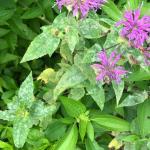 The most common complaint at this time is the super abundance of mosquitoes. Given the frequent rains and standing water, this is not surprising. The mosquitoes are not just a major annoyance. A concern expressed by some landscape workers is the fear of being infected by the West Nile Virus (WNV) as WNV had been detected in mosquitoes in Pittsfield on July 7. Information on protecting oneself from mosquito related diseases can be found at https://www.mass.gov/info-details/mosquito-borne-disease-prevention. The persistent wet weather has also provided ideal conditions for survival of slugs and snails, which are devouring the leaves of a great number of annual and herbaceous perennials. Japanese and Asiatic garden beetles are prominent at this time. Lily leaf beetle adults are still actively feeding on the foliage of true lilies, i.e. genus Lilium. Lush vegetation has led to considerable browsing, mostly by rabbits. Leaf spot diseases are common on a wide range of trees, shrubs, and herbaceous plants. Powdery mildew is prominent on the usual hosts, beebalm (Monarda sp.) and garden phlox (Phlox paniculata). Frequent heavy downpours have resulted in nutrient leaching from soils at many locations. Pale and yellowing of plant foliage due to nutrient deficiency is another common problem at this time.
The most common complaint at this time is the super abundance of mosquitoes. Given the frequent rains and standing water, this is not surprising. The mosquitoes are not just a major annoyance. A concern expressed by some landscape workers is the fear of being infected by the West Nile Virus (WNV) as WNV had been detected in mosquitoes in Pittsfield on July 7. Information on protecting oneself from mosquito related diseases can be found at https://www.mass.gov/info-details/mosquito-borne-disease-prevention. The persistent wet weather has also provided ideal conditions for survival of slugs and snails, which are devouring the leaves of a great number of annual and herbaceous perennials. Japanese and Asiatic garden beetles are prominent at this time. Lily leaf beetle adults are still actively feeding on the foliage of true lilies, i.e. genus Lilium. Lush vegetation has led to considerable browsing, mostly by rabbits. Leaf spot diseases are common on a wide range of trees, shrubs, and herbaceous plants. Powdery mildew is prominent on the usual hosts, beebalm (Monarda sp.) and garden phlox (Phlox paniculata). Frequent heavy downpours have resulted in nutrient leaching from soils at many locations. Pale and yellowing of plant foliage due to nutrient deficiency is another common problem at this time.
Regional Scouting Credits
- CAPE COD REGION - Russell Norton, Horticulture and Agriculture Educator with Cape Cod Cooperative Extension, reporting from Barnstable.
- SOUTHEAST REGION - Brian McMahon, Arborist, reporting from the Dighton area.
- NORTH SHORE REGION - Geoffrey Njue, Green Industry Specialist, UMass Extension, reporting from the Long Hill Reservation, Beverly.
- EAST REGION - Kit Ganshaw & Sue Pfeiffer, Horticulturists reporting from the Boston area.
- METRO WEST REGION – Julie Coop, Forester, Massachusetts Department of Conservation & Recreation, reporting from Acton.
- CENTRAL REGION - Mark Richardson, Director of Horticulture reporting from New England Botanic Garden at Tower Hill, Boylston.
- PIONEER VALLEY REGION - Nick Brazee, Plant Pathologist, UMass Extension Plant Diagnostic Lab, reporting from Amherst.
- BERKSHIRE REGION - Ron Kujawski, Horticultural Consultant, reporting from Great Barrington.
Woody Ornamentals
Diseases
Recent pests, pathogens, or problems of interest seen in the UMass Extension Plant Diagnostic Lab, a select few:
Branch dieback on flowering cherry (Prunus sp.) due to the early February arctic freeze. Two trees growing in separate residential landscapes with a mixture of sun and shade in average soils. In recent weeks, scattered canopy branches have exhibited decline with yellowing and prematurely shedding leaves, leading to an overall collapse. The submitted foliage showed symptoms of water starvation and were not harboring any insect pests or diseases. The branch segments were also free of any diseases or insects. When transverse sections of the twigs and small branches were microscopically evaluated, freeze damage to the vascular tissue was evident. Specifically, there was pale to dark brown discoloration of the tissue scattered throughout, intermixed with areas of healthy tissue. It is suspected that portions of the vascular tissue froze and were badly injured during the arctic freeze event but the twigs and branches were not killed outright. These canopy parts were able to flush new growth this spring and early summer but were unable to withstand the heat and transpirational demands of mid-summer, leading to the collapse.
Diplodia blight, caused by Diplodia sapinea, on cedar of Lebanon (Cedrus libani). The tree is approximately 30- to 40-years-old and resides in clay-loam soils that are compacted and poorly drained. The tree does have a mulched base but is otherwise surrounded by turfgrass. Some supplemental water is provided by lawn sprinklers. Earlier this spring, after new growth flushed, the tree exhibited extensive needle and shoot dieback throughout the canopy. Diplodia sapinea was abundant on the submitted needles and shoot tips. While most common on Pinus, the pathogen has a broad host range among members of the Pinaceae. The tree did not present symptoms of infection in previous years, but may have been predisposed to infection by the poorly drained, heavy soils at the site. Recent research on D. sapinea has shown this fungus can live dormant within healthy plant tissues. Meaning, the fungus has infected the plant but is not causing disease, evading the plant’s defense response as an endophyte. Once the host becomes stressed, by drought or winter injury for example, the fungus starts parasitizing tissues, in this case resulting in needle and shoot blight. Because it has already infected the plant prior to causing disease, the resulting defense response is far less effective. This may explain how outbreaks develop so quickly in some cases, usually on two- and three-needle pines. Sapsucker feeding wounds were also present on the trunk.
Fire blight, caused by the bacterium Erwinia amylovora, on Winesap apple (Malus domestica ‘Stayman’) and Christmas berry (Photinia beauverdiana). In the Northeast, fire blight is a common disease on apple (Malus) and pear (Pyrus). Other members of the rosaceae, including Photinia, can serve as hosts but infections are uncommon to rare. The apple tree is approximately 15-years-old and resides in a sunny field with other apples nearby. In early July, blackened shoot tips were first observed but may have developed earlier in June. The Christmas berry is 43-years-old and resides in an arboretum with a mixture of sun and shade in soils that are not well-drained. Sometime in June, blackened shoot tips developed throughout the canopy and these symptoms have been present in previous years. The plant was diagnosed with fire blight previously (time unknown) and the disease has proved persistent despite efforts to treat it on this particular tree.
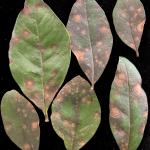 Leaf and stem blight of privet (Ligustrum) caused by the fungal pathogen Alternaria. Two samples from different sites with symptoms of infection developing sometime in June. Brown, circular leaf spots develop on the foliage and these may coalesce to create necrotic blotches. Close examination reveals their zonate pattern of development and expansion. Current season’s stems are also attacked and infected plants can suffer from significant leaf shedding and dieback. Alternaria is often a highly opportunistic pathogen on trees and shrubs, colonizing dying plant tissues as a secondary pathogen. However, in some cases it can be the primary cause of the symptoms. Privet has relatively few pests and diseases and overall; Alternaria blight does not appear to be a common disease on this host. Regardless, the disease has a broad geographic range in southern New England and the lab receives multiple samples each year.
Leaf and stem blight of privet (Ligustrum) caused by the fungal pathogen Alternaria. Two samples from different sites with symptoms of infection developing sometime in June. Brown, circular leaf spots develop on the foliage and these may coalesce to create necrotic blotches. Close examination reveals their zonate pattern of development and expansion. Current season’s stems are also attacked and infected plants can suffer from significant leaf shedding and dieback. Alternaria is often a highly opportunistic pathogen on trees and shrubs, colonizing dying plant tissues as a secondary pathogen. However, in some cases it can be the primary cause of the symptoms. Privet has relatively few pests and diseases and overall; Alternaria blight does not appear to be a common disease on this host. Regardless, the disease has a broad geographic range in southern New England and the lab receives multiple samples each year.
Report by Nick Brazee, Plant Pathologist, UMass Extension Plant Diagnostic Lab, UMass Amherst
Insects and Other Arthropods
Citizen Science Opportunity: Reporting Native Ground Nesting Bees
The Cornell College of Agriculture and Life Sciences and the Cornell Atkinson Center for Sustainability and the Ground Nesting Bees Community Science Project are asking for your help collecting data on native bee populations and nesting sites. Your contributions will help scientists better understand the importance of native bees and how to protect them in our local environments.
What to Look For: Safely monitor ground nesting bees from early spring to late summer. Entrances in grass and soil are indicators of bee activity. Upload a photo of a bee entering or exiting its nest to iNaturalist (GNbee). To learn more, visit: https://www.gnbee.org/ and upload your photos here.
Some notes on safety: take appropriate precautions if you are allergic to bee stings. While many ground nesting bees or wasps do not sting, it is not a guarantee that you will not encounter a stinging species if participating.
Current Nuisance Problems of Note:
- Deer Tick/Blacklegged Tick: Ixodes scapularis adults are active all winter and spring, as they typically are from October through May, and “quest” or search for hosts at any point when daytime temperatures are above freezing. Engorged females survive the winter and lay 1,500+ eggs in the forest leaf litter beginning around Memorial Day (late May). For images of all deer tick life stages, along with an outline of the diseases they carry, visit: https://www.capecod.gov/departments/cooperative-extension/programs/ticks-bugs/ or https://web.uri.edu/tickencounter/species/blacklegged-tick/.
Anyone working in the yard and garden should be aware that there is the potential to encounter deer ticks. The deer tick or blacklegged tick can transmit Lyme disease, human babesiosis, human anaplasmosis, and other diseases. Preventative activities, such as daily tick checks, wearing appropriate clothing, and permethrin treatments for clothing (according to label instructions) can aid in reducing the risk that a tick will become attached to your body. If a tick cannot attach and feed, it will not transmit disease. For more information about personal protective measures, visit: https://www.capecod.gov/departments/cooperative-extension/programs/ticks-bugs/.
The Center for Agriculture, Food, and the Environment provides a list of potential tick identification and testing resources.
*In the news: UMass Amherst has now been designated as the location for the New England Center of Excellence in Vector-Borne Diseases (NEWVEC). This CDC (Centers for Disease Control and Prevention) funded center will work to reduce the risk of vector-borne diseases spread by ticks, mosquitoes, and other blood-sucking insects or insect relatives in New England. For more information and to contact NEWVEC, visit: https://www.newvec.org/. To contact the center for more information about their Spring 2023 Project ITCH (“Is Tick Control Helping”), visit: https://www.newvec.org/itch .
- Mosquitoes: According to the Massachusetts Bureau of Infectious Disease and Laboratory Science and the Department of Public Health, there are at least 51 different species of mosquito found in Massachusetts. Mosquitoes belong to the Order Diptera (true flies) and the Family Culicidae (mosquitoes). As such, they undergo complete metamorphosis, and possess four major life stages: egg, larva, pupa, and adult. Adult mosquitoes are the only stage that flies and many female mosquitoes only live for 2 weeks (although the life cycle and timing will depend upon the species). Only female mosquitoes bite to take a blood meal, and this is so they can make eggs. Mosquitoes need water to lay their eggs in, so they are often found in wet or damp locations and around plants. Different species prefer different habitats. It is possible to be bitten by a mosquito at any time of the day, and again timing depends upon the species. Many are particularly active from just before dusk, through the night, and until dawn. Mosquito bites are not only itchy and annoying, but they can be associated with greater health risks. Certain mosquitoes vector pathogens that cause diseases such as West Nile virus (WNV) and eastern equine encephalitis (EEE).
Click here for more information about mosquitoes in Massachusetts.
EEE and WNV testing and tracking for this season began on June 12, 2023. The Massachusetts Department of Public Health tracks animal cases, human cases, and mosquito positive samples from traps from June through October in Massachusetts. The first West Nile Virus positive mosquito sample was collected on July 6, 2023, in the town of Brookline in Norfolk County, MA. State officials announced this detection at https://www.mass.gov/news/state-public-health-officials-announce-seasons-first-west-nile-virus-positive-mosquito-sample. Click here for more information.
Additionally, WNV positive mosquito samples have been collected in Boston, Pittsfield, West Springfield, and Worcester as of July 20, 2023.
There are ways to protect yourself against mosquitoes, including wearing long-sleeved shirts and long pants, keeping mosquitoes outside by using tight-fitting window and door screens, and using insect repellents as directed. Products containing the active ingredients DEET, permethrin, IR3535, picaridin, and oil of lemon eucalyptus provide protection against mosquitoes. Be aware that not all of these can be safely used on young children. Read and follow all label instructions for safety and proper use.
Click here for more information about mosquito repellents.
- Wasps/Hornets: Many wasps are predators of other arthropods, including pest insects such as certain caterpillars that feed on trees and shrubs. Adult wasps hunt prey and bring it back to their nest where young are being reared, as food for the immature wasps. A common such example are the paper wasps (Polistes spp.) who rear their young on chewed up insects. They may be seen searching plants for caterpillars and other soft-bodied larvae to feed their young. Paper wasps can sting, and will defend their nests, which are open-celled paper nests that are not covered with a papery “envelope”. These open-celled nests may be seen hanging from eaves or other outdoor building structures. Aerial yellow jackets and hornets create large aerial nests that are covered with a papery shell or “envelope”. Common yellow jacket species include those in the genus Vespula. Dolichovespula maculata is commonly known as the baldfaced hornet, although it is not a true hornet. The European hornet (Vespa crabro) is three times the size of a yellow jacket and may be confused for the northern* giant hornet (Vespa mandarinia). The European hornet is known to Massachusetts, but the northern giant hornet is not. The European hornet is known to Massachusetts, but the northern giant hornet is not. Homeowners in Massachusetts are beginning to report sightings of the European hornet in 2023. European hornets have black, tear-drop shaped markings on their abdomens, but northern giant hornets do not. If you are concerned that you have found or photographed a northern giant hornet, please report it here: https://massnrc.org/pests/report.aspx. Paper wasps and aerial yellowjackets overwinter as fertilized females (queens) and a single female produces a new nest annually in the late spring. Queens start new nests, lay eggs, and rear new wasps to assist in colony/nest development.Nests are abandoned at the end of the season. Some people are allergic to stinging insects, so care should be taken around wasp/hornet nests. Unlike the European honeybee (Apis mellifera), wasps and hornets do not have barbed stingers, and therefore can sting repeatedly when defending their nests. It is best to avoid them, and if that cannot be done and assistance is needed to remove them, consult a professional.
*Read more about the common name change for Vespa mandarinia.
Woody ornamental insect and non-insect arthropod pests to consider, a selected few:
Highlighted Invasive Insects & Other Organisms Update:
- Southern Pine Beetle: Dendroctonus frontalis has been collected in traps in Massachusetts and other parts of New England in recent years. Historically, the southern pine beetle has been native to the southeastern United States, however its range is moving northward due to warming winters and climate change. The Massachusetts Department of Conservation and Recreation (DCR) Forest Health Program, has announced that they have detected the first pocket of southern pine beetle killed trees (pitch pine, Pinus rigida) in Massachusetts on Nantucket. This is the first observation of this species killing trees in the state. An active infestation of southern pine beetle was found killing trees in recent weeks and MA DCR is working with the property owner to determine next steps and potential management options at the site. If you believe you have detected southern pine beetles in trees in Massachusetts, please contact Nicole Keleher, MA DCR Forest Health Director, at: nicole.keleher@mass.gov. More information about southern pine beetle is also available from MA DCR at https://storymaps.arcgis.com/stories/b60f63199fa14805a8b9f7c82447a25b .
The southern pine beetle (SPB) undergoes complete metamorphosis (is holometabolous) with four life stages: egg, larva, pupa, and adult. Adults are dark red/brown to black in color and 1/16 – 1/8” in length. Eggs are white and larvae are crescent-shaped with a dark red/brown head and a white body. Four larval instars are present, with pupa being bright white. The adult is light brown in color prior to drying and hardening and becoming darker in color. Female beetles select suitable host trees and release chemical pheromones to attract male mates. She will penetrate the bark and begin creating a gallery where she is joined by the male and mates. Early attacks to the tree may be “pitched out” by the resin defenses of the tree. The pheromones produced by the females and the volatile chemicals expressed by the stressed host plant attract additional males and females. If tree defenses can be overcome, females will colonize beneath the bark, creating S-shaped galleries. The inoculation of the tree with a blue stain fungus as well as other fungi occurs with colonization of southern pine beetle, however, it is the act of "mass attack" by the insects themselves which leads to tree mortality. Entomocorticium spp. symbiotic fungi are associated with southern pine beetles and the immature larvae feed on this fungus. Females may lay up to 160 eggs in their lifetime and development can take as little as 26 days in warmer climates. In the South, 3-9 generations of SPB have been observed to occur per year. In NY, 3-4 generations have been observed on Long Island. Current Massachusetts temperatures should keep the number of generations per year to the lower end of this range.
Southern pine beetle can be detected most easily by the presence of popcorn-sized pitch tubes on the outer bark of trunks and branches. Pitch tubes can range in color from white to red. They can occur from ground level to high in the canopy of the tree. Exit holes (about 1/16” in diameter) can be observed in the bark from emerging adults. S-shaped galleries can also be observed by peeling back any bark that may be falling off the tree. Brown-orange frass (excrement) that looks like wood shavings is found packed within the galleries. By the time foliage fades from green to yellow to brown, the infestation may be advanced. The presence of certain checkered or clerid beetles can also indicate high populations of southern pine beetle, as these checkered beetles prey upon SPB. Southern pine beetle prefers trees damaged by lightning strikes or fire. In the southeastern part of the insect's range, southern pine beetle is not known to preferentially attack drought stressed or chronically stressed trees. Trees under 15 years of age or 2 inches in diameter may be seldom attacked.
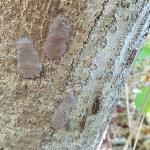 Spotted Lanternfly: (Lycorma delicatula, SLF) is a non-native, invasive insect that feeds on over 103 species of plants, including many trees and shrubs that are important in our landscapes. It overwinters as an egg mass, which the adult female insect lays on just about any flat surface. Pictures of egg masses can be seen here.
Spotted Lanternfly: (Lycorma delicatula, SLF) is a non-native, invasive insect that feeds on over 103 species of plants, including many trees and shrubs that are important in our landscapes. It overwinters as an egg mass, which the adult female insect lays on just about any flat surface. Pictures of egg masses can be seen here.
Eggs have hatched and spotted lanternfly will pass through four nymphal instars before maturing into the adult life stage. Adults are typically present by late July and the beginning of August.
Currently, the only established populations of spotted lanternfly in Massachusetts are in Fitchburg, Shrewsbury, Worcester, and Springfield MA. Therefore, there is no reason to be preemptively treating for this insect in other areas of Massachusetts. If you suspect you have found spotted lanternfly in additional locations, please report it immediately to MDAR here. If you are living and working in the Fitchburg, Shrewsbury, Worcester, and Springfield, MA areas, please be vigilant and continue to report anything suspicious.
For More Information:
From UMass Extension:
*New*: Spotted Lanternfly Management Guide for Professionals
*Note that management may only be necessary in areas where this insect has become established in Massachusetts, and if high value host plants are at risk. Preemptive management of the spotted lanternfly is not recommended.
Check out the InsectXaminer Episode about spotted lanternfly adults and egg masses!
From the MA Department of Agricultural Resources (MDAR):
Spotted Lanternfly Fact Sheet and Map of Locations in MA
Spotted Lanternfly Management Guide for Homeowners in Infested Areas
*New*: Spotted Lanternfly Look-alikes in MA
*New*: Spotted Lanternfly Egg Mass Look-alikes
- Asian Longhorned Beetle: (Anoplophora glabripennis, ALB) Look for signs of an ALB infestation which include perfectly round exit holes (about the size of a dime), shallow oval or round scars in the bark where a female has chewed an egg site, or sawdust-like frass (excrement) on the ground nearby host trees or caught in between branches. Be advised that other, native insects may create perfectly round exit holes or sawdust-like frass, which can be confused with signs of ALB activity.
Adult Asian longhorned beetles typically begin to emerge from trees by July 1st in Massachusetts. It is important to take photographs of and report any suspicious longhorned beetles to the Asian Longhorned Beetle Eradication Program phone numbers listed below.
The regulated area for Asian longhorned beetle is 110 square miles encompassing Worcester, Shrewsbury, Boylston, West Boylston, and parts of Holden and Auburn. If you believe you have seen damage caused by this insect, such as exit holes or egg sites, on susceptible host trees like maple, please call the Asian Lonbghorned Beetle Eradication Program office in Worcester, MA at 508-852-8090 or toll free at 1-866-702-9938.
Report an Asian longhorned beetle find online or compare it to common insect look-alikes here.
 Emerald Ash Borer: (Agrilus planipennis, EAB) has been detected in at least 11 out of the 14 counties in Massachusetts. A map of these locations across the state may be found at https://ag.umass.edu/fact-sheets/emerald-ash-borer . Additional information about this insect is provided by the MA Department of Conservation and Recreation at https://storymaps.arcgis.com/stories/b60f63199fa14805a8b9f7c82447a25b.
Emerald Ash Borer: (Agrilus planipennis, EAB) has been detected in at least 11 out of the 14 counties in Massachusetts. A map of these locations across the state may be found at https://ag.umass.edu/fact-sheets/emerald-ash-borer . Additional information about this insect is provided by the MA Department of Conservation and Recreation at https://storymaps.arcgis.com/stories/b60f63199fa14805a8b9f7c82447a25b.
This wood-boring beetle readily attacks ash (Fraxinus spp.) including white, green, and black ash and has also been found developing in white fringe tree (Chionanthus virginicus) and has been reported in cultivated olive (Olea europaea). Signs of an EAB infested tree may include D-shaped exit holes in the bark (from adult emergence), “blonding” or lighter coloration of the ash bark from woodpecker feeding (chipping away of the bark as they search for larvae beneath), and serpentine galleries visible through splits in the bark, from larval feeding beneath. It is interesting to note that woodpeckers are capable of eating 30-95% of the emerald ash borer larvae found in a single tree (Murphy et al. 2018). Unfortunately, despite high predation rates, EAB populations continue to grow. However, there is hope that biological control efforts will eventually catch up with the emerald ash borer population and preserve some of our native ash tree species for the future.
- Jumping Worms: Amynthas spp. earthworms, collectively referred to as “jumping or crazy or snake” worms, overwinter as eggs in tiny, mustard-seed sized cocoons found in the soil or other substrate (ex. compost). Immature jumping worms hatch from their eggs by approximately mid-to-late May. It may be impossible to see them at first, and it may be more likely that jumping worms are noticed when the first adults begin to appear at the end of May and in June. It is easy to misidentify jumping worms (ex. mistake European earthworms for jumping worms) if only juveniles are found. In August and September, most jumping worms have matured into the adult life stage and identification of infestations is more likely to occur at that time of year.
For More Information, see these UMass Extension Fact Sheets:
Earthworms in Massachusetts – History, Concerns, and Benefits
Jumping/Crazy/Snake Worms – Amynthas spp.
A Summary of the Information Shared at UMass Extension’s Jumping Worm Conference in January 2022
Invasive Jumping Worm Frequently Asked Questions (Over 70 Questions and their Answers)
Tree & Shrub Insect Pests (Native and Invasive):
- Andromeda Lace Bug: Stephanitis takeyai is most commonly encountered on Japanese Andromeda. Eggs are tiny and inserted into the midveins on the lower surface of the leaf and covered with a coating that hardens into a protective covering. 5 nymphal stages are reported. Nymphs are different in appearance from the adults, often covered with spiky protrusions. 3-4 generations per year have been observed in New England, with most activity seen between late-May into September (starting at approximately 120 GDD’s, Base 50°F). Both nymphs and adults can be seen feeding on leaf undersides. Adults have delicate, lace-like wings and what appears to be an "inflated hood" that covers their head. Adults are approximately 1/8 of an inch long. Arrived in the US in Connecticut in 1945 from Japan (Johnson and Lyon, 1991).
Can cause severe injury to Japanese andromeda, especially those in full sun. Mountain Andromeda (Pieris floribunda) is highly resistant to this pest. Like other lace bugs, this insect uses piercing-sucking mouthparts to drain plant fluids from the undersides of the leaves. Damage may be first noticed on the upper leaf surface, causing stippling and chlorosis (yellow or off-white coloration). Lace bug damage is distinguished from that of other insects upon inspecting the lower leaf surface for black, shiny spots, "shed" skins from the insects, and adult and nymphal lace bugs themselves.
A first sign of potential lace bug infestation is stippling or yellow/white colored spots or chlorosis on host plant leaf surfaces. Lace bugs excrete a shiny, black, tar-like excrement that can often be found on the undersides of infested host plant leaves. Flip leaves over to inspect for this when lace bug damage is suspected.
Mountain Andromeda (Pieris floribunda) is considered to be highly resistant to this insect and can be used as an alternative for such plantings, along with other lace bug-resistant cultivars. Consider replacing Japanese Andromeda with mountain andromeda as a way to manage for this pest. Natural enemies are usually predators, and sometimes not present in large enough numbers in landscapes to reduce lace bug populations. Structurally and (plant) species complex landscapes have been shown to reduce azalea lace bug (Stephanitis pyrioides) populations through the increase of natural enemies.
- Asiatic Garden Beetle: Maladera castanea adults are active and are typically most abundant in July and August. These rusty-red colored beetles are bullet-shaped and active at night. They are often attracted to porch lights. This beetle feeds on a number of ornamental plants, defoliating leaves by giving the edges a ragged appearance and also feeding on blossoms. Butterfly bush, rose, dahlia, aster, and chrysanthemum can be favored hosts.
- Azalea Lace Bug: Stephanitis pyrioides is native to Japan. The azalea lace bug deposits tiny eggs on the midveins on leaf undersides. They then cover the area where the egg was inserted with a brownish material that hardens into a protective covering. Each female may lay up to 300 eggs (University of Florida). Nymphs hatch from the eggs and pass through 5 instars. The length of time this takes depends on temperature. Between 2 and 4 generations may be completed in a single year. In Maryland, there are four generations per year. Adults are approximately 1/10 of an inch in length with lacy, cream colored, transparent wings held flat against the back of the insect. Wings also have black/brown patches. Adults of this species also possess a "hood" over their head. Nymphs are colorless upon hatch from the egg, but develop a black color as they mature and are covered in spiny protrusions.
Immatures and adults use piercing-sucking mouthparts to remove plant fluids from leaf tissues. This feeding leaves behind white-yellow stippling on the upper surface of host plant leaves, even though the insects themselves feed on the underside of the leaf. Plants in full sun are often particularly damaged by these insects. In heavy infestations, plants in full sun may be killed by the feeding of the azalea lace bug.
Begin scouting for azalea lace bugs when 120 GDD’s (Base 50°F) are reached. This species is active throughout the summer, following. Look for dark, black tar-like spots of excrement deposited by immature and adult lace bugs on the underside of susceptible host plant leaves, especially on leaves with white-yellow stippling visible on the upper surface. If lace bugs are not already known to the location, check susceptible hosts located in full sun first. Monitor plants for lace bug feeding from late April through the summer.
Plant azaleas in partial shade. Resistance has been reported in Rhododendron atlanticum, R. arborescens, R. canescens, R. periclymenoides, and R. prunifolium.
Many of the natural enemies reported for this insect are predators. They are rarely abundant enough to reduce damaging populations of lace bugs, especially on plants in sunny locations. Structurally and (plant) species complex landscapes have been shown to reduce azalea lace bug (Stephanitis pyrioides) populations through the increase of natural enemies.
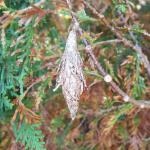
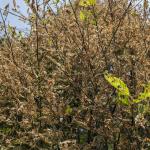
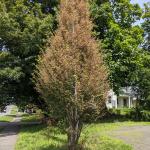

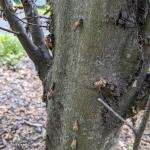 Bagworm: Thyridopteryx ephemeraeformis is a native species of moth whose larvae construct bag-like coverings over themselves with host plant leaves and twigs. This insect overwinters in the egg stage, within the bags of deceased females from last season. Eggs may hatch and young larvae are observed feeding around mid-June, or roughly between 600-900 GDD’s. Newly hatched and feeding bagworm caterpillars are small and less likely to be noticed. By late July and August, these caterpillars will be large and their feeding noticeable on individual trees and shrubs. Bagworm caterpillars were observed in abundance feeding on columnar hornbeam planted approximately 5 years ago in Amherst, MA on 7/19/2023 and reported by Alan Snow, Tree Warden, Town of Amherst. The tree was almost completely defoliated, with brown leaves looking as if they were scorched by fire. Approximately ½ inch long caterpillars littered the ground beneath the tree and could be seen climbing up the trunk or dangling from branches on silken threads. Continue to monitor susceptible host plants for bagworm caterpillars into August.
Bagworm: Thyridopteryx ephemeraeformis is a native species of moth whose larvae construct bag-like coverings over themselves with host plant leaves and twigs. This insect overwinters in the egg stage, within the bags of deceased females from last season. Eggs may hatch and young larvae are observed feeding around mid-June, or roughly between 600-900 GDD’s. Newly hatched and feeding bagworm caterpillars are small and less likely to be noticed. By late July and August, these caterpillars will be large and their feeding noticeable on individual trees and shrubs. Bagworm caterpillars were observed in abundance feeding on columnar hornbeam planted approximately 5 years ago in Amherst, MA on 7/19/2023 and reported by Alan Snow, Tree Warden, Town of Amherst. The tree was almost completely defoliated, with brown leaves looking as if they were scorched by fire. Approximately ½ inch long caterpillars littered the ground beneath the tree and could be seen climbing up the trunk or dangling from branches on silken threads. Continue to monitor susceptible host plants for bagworm caterpillars into August.
- Cottony Taxus Scale: Pulvinaria floccifera, also referred to as the cottony camellia scale, utilizes such hosts as taxus, camellia, holly, hydrangea, Japanese maple, euonymus, magnolia, and jasmine, among others. Females have laid the long, narrow, white and fluted egg sac that makes them much more noticeable. Eggs will hatch over an extended period of 6 weeks and crawlers may be treated between 802-1388 GDD’s. This insect can cause the host to appear off-color. They also produce honeydew which promotes sooty mold growth. Dieback is not common with this insect. Target the underside of the foliage. Horticultural oil, neem oil, and insecticidal soaps may be used to manage these soft scales. Reduced risk options help preserve natural enemies.
- Dogwood Sawfly: Macremphytus tarsatus has one generation per year. The larvae of the dogwood sawfly overwinter in decaying wood and occasionally compromised structural timber. An overwintering "cell" is created in this soft wood. Pupation occurs in the springtime and adults can take a lengthy time to emerge, roughly between late May and July. 100+ eggs are laid in groups on the underside of leaves. Eggs hatch and the larvae feed gregariously, initially skeletonizing leaves. As the caterpillars grow in size, they are capable of eating the entire leaf with the exception of the midvein. Larval appearance varies greatly throughout instars, so much so that one might mistake them for multiple species. Early instars are translucent and yellow, but as the caterpillars grow they develop black spots (over yellow) and become covered in a white powder-like material. Larvae and their shed skins may resemble bird droppings. Full grown larvae begin to wander in search of a suitable overwintering location. Rotting wood lying on the ground is preferred for this.
Foliage of dogwood, especially gray dogwood (Cornus racemosa) may be impacted. Skeletonizes leaves at first, then eats all but the midvein.
- Fall Webworm: Hyphantria cunea is native to North America and Mexico. It is now considered a world-wide pest, as it has spread throughout much of Europe and Asia. (For example, it was introduced accidentally into Hungary from North America in the 1940’s.) Hosts include nearly all shade, fruit, and ornamental trees except conifers. In the USA, at least 88 species of trees are hosts for these insects, while in Europe at least 230 species are impacted. In the past history of this pest, it was once thought that the fall webworm was a two-species complex. It is now thought that H. cunea has two color morphs – one black headed and one red headed. These two color forms differ not only in the coloration of the caterpillars and the adults, but also in their behaviors. Caterpillars may go through at least 11 molts, each stage occurring within a silken web they produce over the host. When alarmed, all caterpillars in the group will move in unison in jerking motions that may be a mechanism for self-defense. Depending upon the location and climate, 1-4 generations of fall webworm can occur per year. Fall webworm adult moths lay eggs on the underside of the leaves of host plants in the spring. These eggs hatch in late June or early July depending on climate. Young larvae feed together in groups on the undersides of leaves, first skeletonizing the leaf and then enveloping other leaves and eventually entire branches within their webs. Webs are typically found on the terminal ends of branches. All caterpillar activity occurs within this tent, which becomes filled with leaf fragments, cast skins, and frass. Fully grown larvae then wander from the webs and pupate in protected areas such as the leaf litter where they will remain for the winter. Adult fall webworm moths emerge the following spring/early summer to start the cycle over again. 50+ species of parasites and 36+ species of predators are known to attack fall webworm in North America. Fall webworms typically do not cause extensive damage to their hosts. Nests may be an aesthetic issue for some. If in reach, small fall webworm webs may be pruned out of trees and shrubs and destroyed. Do not set fire to H. cunea webs when they are still attached to the host plant.
 Imported Willow Leaf Beetle: Plagiodera versicolora adult beetles overwinter near susceptible hosts. Adult beetles will chew holes and notches in the leaves of willow once they become available. Females lay yellow eggs in clusters on the undersides of leaves. Larvae are slug-like and bluish-green in color. They will feed in clusters and skeletonize the leaves. Adult imported willow leaf beetles are still very active in Boylston, MA as of 6/27/2023 on their namesake host plants. Most plants can tolerate the feeding from this insect, and foliage will appear brown. Repeated yearly feeding can be an issue, in which case management of the young larvae may be necessary. Take care with treatment in areas near water.
Imported Willow Leaf Beetle: Plagiodera versicolora adult beetles overwinter near susceptible hosts. Adult beetles will chew holes and notches in the leaves of willow once they become available. Females lay yellow eggs in clusters on the undersides of leaves. Larvae are slug-like and bluish-green in color. They will feed in clusters and skeletonize the leaves. Adult imported willow leaf beetles are still very active in Boylston, MA as of 6/27/2023 on their namesake host plants. Most plants can tolerate the feeding from this insect, and foliage will appear brown. Repeated yearly feeding can be an issue, in which case management of the young larvae may be necessary. Take care with treatment in areas near water.
Check out Episode 4 of InsectXaminer to see the imported willow leaf beetle in action.
- Magnolia Scale: Neolecanium cornuparvum is distributed throughout the eastern United States. Host plants include: Magnolia stellata (star Magnolia), M. acuminata (cucumber magnolia), M. lilliflora ‘Nigra’ (lily magnolia; formerly M. quinquepeta), and M. soulangeana (Chinese magnolia). Other species may be hosts for this scale but attacked to a lesser degree. M. grandiflora (southern magnolia) may be such an example.
Mature individuals settle on a location on branches and twigs, then insert piercing-sucking mouthparts to feed. The insects feed on plant fluids and excrete large amounts of a sugary substance known as honeydew. Sooty mold, often black in color, will then grow on the honeydew that has coated branches and leaves. Repeated, heavy infestations can result in branch dieback and at times, death of the plant. Honeydew may also be very attractive to ants, wasps, and hornets. The magnolia scale overwinters as a young nymph (immature stage) which is elliptical in shape, mostly a dark-slate gray, except for a median ridge that is red/brown in color. These overwintering nymphs may be found on the undersides of 1st and 2nd year old twigs. The first molt (shedding of the exoskeleton to allow growth) can occur by late April or May in parts of this insect’s range and the second molt will occur in early June. At that time, the immature scales have turned a deep purple color. Stems of the host plant may appear purple in color and thickened – but this is a coating of nymphal magnolia scales, not the stem itself. Eventually, these immature scales secrete a white layer of wax over their bodies, looking as if they have been rolled in powdered sugar. By August, the adult female scale is fully developed, elliptical and convex in shape, and ranging from a pinkish-orange to a dark brown color. Adult females may also be covered in a white, waxy coating. By that time, the females produce nymphs (living young; eggs are not “laid”) that wander the host before settling on the newest twigs to overwinter. In the Northeastern United States, this scale insect has a single generation per year.
- Mimosa Webworm: Homadaula anisocentra was first detected in the United States in 1940 in Washington, D.C. on its common namesake host plant. Originally from China, the mimosa webworm is primarily a pest of honeylocust (Gleditsia triacanthos; including thornless cultivars). This insect is found throughout the eastern and midwestern states and California. In the warmer parts of its range in the United States, it has historically heavily attacked mimosa where it grows. Adults are moths that are silvery gray in color with wings interrupted by black dots. Moths are approximately 13 mm in size (wingspan). Fully grown larvae reach up to 16 mm long and are variable in color from gray to brown with five longitudinal white stripes. Once mature, the caterpillars move to the bark scales of their host plants and find sheltered places to pupate. They may also be found in the leaf litter beneath host plants, pupating in a cocoon. Pupae are yellowish brown, 6 mm long, and encased in a white cocoon. Adult moths may emerge in early-mid June and lay gray eggs on the leaves of their hosts that turn a rose color just prior to hatch. Eggs hatch and feeding caterpillars web the foliage together, feeding within the web for protection. Larvae may be found feeding together in groups, in which case larger and aesthetically displeasing webs may be created. If disturbed, the larvae may move quickly and can drop from the web on a line of silk. A second generation of moths may occur, with pupation happening and adults emerging by August in warmer locations. In New York and New England, it is likely that this second generation emerges in September and any offspring may be killed with the winter. In the warmest parts of this insect's introduced range in the United States, three generations may be possible per year.
The larvae (caterpillars) of this insect tie the foliage of their hosts together with silken strands and skeletonize the leaves. Injury to host plant leaves may be noticeable by early July in Massachusetts. Foliage can appear bronzed in color from the feeding. Webbing usually begins at the tops of trees. An entire tree may become covered in the webs created by these caterpillars. So much webbing can often make it difficult to assess the extent of the defoliation or damage caused on an individual host.
Certain cultivars of honeylocust may vary in their susceptibility to this insect. Gleditsia triacanthos 'Sunburst' was highly susceptible to attack in Indiana. Cultivars such as 'Moraine', 'Shademaster', and 'Imperial' may be less susceptible - however, they are still able to be fed upon by this insect, so annual monitoring may be necessary.
- Two-Spotted Spider Mite: Tetranychus urticae is a “warm-season” mite that loves hot and dry weather, which may favor the quick reproduction and build-up of this pest. Management should seek to preserve beneficial predatory mites. Monitor susceptible hosts (elm, maple, redbud, ash, black locust, tuliptree, and many deciduous shrubs) for increasing numbers of these mites until mid-August. Mites will be found on the undersides of leaves and cause stippling of the foliage.
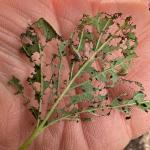 Viburnum Leaf Beetle: Pyrrhalta viburni is a beetle in the family Chrysomelidae that is native to Europe, but was found in Massachusetts in 2004. By 2008, viburnum leaf beetle was considered to be present throughout all of Massachusetts. Larvae are present and feeding on plants from approximately late April to early May until they pupate sometime in June. Much damage from viburnum leaf beetle feeding is currently apparent in areas of Massachusetts where this insect has become established. See photo courtesy of Tom Ingersoll from 6/5/2023. Adult beetles emerge from pupation by approximately mid-July and will also feed on host plant leaves, mate, and lay eggs at the ends of host plant twigs where they will overwinter. This beetle feeds exclusively on many different species of viburnum, which includes, but is not limited to, susceptible plants such as V. dentatum, V. nudum, V. opulus, V. propinquum, and V. rafinesquianum. Some viburnum have been observed to have varying levels of resistance to this insect, including but not limited to V. bodnantense, V. carlesii, V. davidii, V. plicatum, V. rhytidophyllum, V. setigerum, and V. sieboldii. More information about viburnum leaf beetle may be found at http://www.hort.cornell.edu/vlb/ and at https://ag.umass.edu/landscape/fact-sheets/viburnum-leaf-beetle.
Viburnum Leaf Beetle: Pyrrhalta viburni is a beetle in the family Chrysomelidae that is native to Europe, but was found in Massachusetts in 2004. By 2008, viburnum leaf beetle was considered to be present throughout all of Massachusetts. Larvae are present and feeding on plants from approximately late April to early May until they pupate sometime in June. Much damage from viburnum leaf beetle feeding is currently apparent in areas of Massachusetts where this insect has become established. See photo courtesy of Tom Ingersoll from 6/5/2023. Adult beetles emerge from pupation by approximately mid-July and will also feed on host plant leaves, mate, and lay eggs at the ends of host plant twigs where they will overwinter. This beetle feeds exclusively on many different species of viburnum, which includes, but is not limited to, susceptible plants such as V. dentatum, V. nudum, V. opulus, V. propinquum, and V. rafinesquianum. Some viburnum have been observed to have varying levels of resistance to this insect, including but not limited to V. bodnantense, V. carlesii, V. davidii, V. plicatum, V. rhytidophyllum, V. setigerum, and V. sieboldii. More information about viburnum leaf beetle may be found at http://www.hort.cornell.edu/vlb/ and at https://ag.umass.edu/landscape/fact-sheets/viburnum-leaf-beetle.
Concerned that you may have found an invasive insect or suspicious damage caused by one? Need to report a pest sighting? If so, please visit the Massachusetts Introduced Pests Outreach Project.
Reported by Tawny Simisky, Extension Entomologist, UMass Extension Landscape, Nursery, & Urban Forestry Program
Landscape Weeds
For identification of weed species noted below, refer to UMass Extension's Weed Herbarium.
Summer annual weeds in landscape beds continue to get larger as a result of warm and rainy weather patterns. Using a non-selective herbicide will result in unsightly dead vegetation, so hand weeding may be needed. Physical removal by hand weeding might require laying down a fresh mulch layer since the existing mulch barrier may be compromised. A fresh layer of mulch will cover any plants you could not remove as well as provide protection against the germination of winter annual weeds later in the season.
Monitor mulches in landscape beds as some of the torrential rainfall events may have moved mulch and left bare soil. Consider re-mulching these areas.
Poison ivy is in fruit and should be treated now. Glyphosate or triclopyr are the best herbicides for poison ivy control. Triclopyr products should be selected over glyphosate in areas where grasses need to be saved. Contact types (ScytheTM, RewardTM) or the non-chemical/organic herbicide products will provide “burndown” activity only and will not adequately control poison ivy. REMEMBER, the oil in poison ivy known as urushiol is still active in the plant after the plant is dead and can still cause contact dermatitis. Urushiol occurs in all parts of the plant, including the roots.
There have been several reports of seedlings of woody plants growing in landscape beds. The most notable species are maple (red, sugar and silver) and oak. The UMass Extension Plant Diagnostic Lab recently identified seedlings of rose-of-Sharon a.k.a. Althea, Hibiscus syriacus, creating a seedling mat in a landscape on the Cape. Rose-of-Sharon is a prolific seeder. These seedlings can be cut as close to the ground as possible or treated with a directed spray of the non-selective herbicides glyphosate or glufosinate.
We are moving closer to the application window for the effective control of Japanese knotweed. Late last week, the initial growth of the floral structures of Japanese knotweed were observed in western Massachusetts. Since knotweed is commonly found in wet areas or near a stream, river, or wetland, its management may invoke 310 CMR 10.00: the Massachusetts Wetlands Protection Act. 310 CMR 10.00 regulates all activities in the resource areas identified in the act. If a knotweed management project is being considered, now is the time to begin work with the Conservation Commission in the municipality to determine to what extent the Act might impact your project. For states other than Massachusetts, you should seek information about that state’s regulations for activities near water. Application timing and herbicide product selection will be provided when the application window for effective control arrives later in the season.
Reported by Randy Prostak, Weed Specialist, UMass Extension Landscape, Nursery, & Urban Forestry Program
Odds and Ends
UMass Extension Freeze Event Impacts Survey!
The freeze events of February 3-4 and May 18, 2023, had significant impacts on agricultural sectors including tree fruits, berries, vegetables, ornamentals, and others. Now that losses are evident for most crops, UMass Extension and our partners* hope to generate timely reporting on losses at the state and regional levels. If you produce agricultural crops (including nursery stock) and you experienced crop losses due to the February 3-4 deep freeze and/or the May 18th freeze, please report them by filling out this survey: https://umassamherst.co1.qualtrics.com/jfe/form/SV_b2BKrQXOUpV8aNg. The survey deadline is July 31.
This data will help document the extent of crop and economic losses and will inform the public and decision-makers who may be considering actions that would provide emergency funds to Massachusetts producers. Some growers may also receive insurance payments or be eligible for low-interest FSA loans or other USDA disaster programs. However, data from these programs will take many months to report, and may under-report losses in some sectors. Producers should also report losses to their local FSA office as soon as the extent of the damage can be assessed - this survey is not intended to take the place of reporting to FSA.
Your data and privacy will be protected. Please see details in the opening page of the survey and on the final page, where you may choose to provide and share contact information if you wish. No crop loss data at the individual farm level will be shared.
*Partners include: USDA Farm Services Agency, USDA Risk Management Agency, MA Department of Agricultural Resources, MA Farm Bureau Federation, MA Food System Collaborative, MA Fruit Growers’ Association, New England Vegetable and Berry Growers Association, Community Involved in Sustaining Agriculture (CISA), Southeast MA Agricultural Partnership (SEMAP), and Berkshire Grown.
If you have questions about this survey, please contact cclay@umext.umass.edu.
Additional Resources
Pesticide License Exams - The MA Dept. of Agricultural Resources (MDAR) is now holding exams online. For more information and how to register, go to: https://www.mass.gov/pesticide-examination-and-licensing.
To receive immediate notification when the next Landscape Message update is posted, join our e-mail list or follow us on Facebook.
For a complete listing of landscape, nursery, and urban forestry program upcoming events, see our calendar at https://ag.umass.edu/landscape/upcoming-events.
For commercial growers of greenhouse crops and flowers - Check out UMass Extension's Greenhouse Update website.
For professional turf managers - Check out our Turf Management Updates.
For home gardeners and garden retailers - Check out our home lawn and garden resources.
Diagnostic Services
UMass Laboratory Diagnoses Landscape and Turf Problems - The UMass Extension Plant Diagnostic Lab is available to serve commercial landscape contractors, turf managers, arborists, nurseries and other green industry professionals. It provides woody plant and turf disease analysis, woody plant and turf insect identification, turfgrass identification, weed identification, and offers a report of pest management strategies that are research based, economically sound and environmentally appropriate for the situation. Accurate diagnosis for a turf or landscape problem can often eliminate or reduce the need for pesticide use. For sampling procedures, detailed submission instructions and a list of fees, see the Plant Diagnostic Laboratory web site.
Soil and Plant Nutrient Testing - The University of Massachusetts Soil and Plant Nutrient Testing Laboratory is located on the campus of the University of Massachusetts at Amherst. Testing services are available to all. The lab provides test results and recommendations that lead to the wise and economical use of soils and soil amendments. For more information, including current turn-around times, visit the UMass Soil and Plant Nutrient Testing Laboratory web site. The lab is currently accepting orders for Routine Soil Analysis (including optional Organic Matter, Soluble Salts, and Nitrate testing), Particle Size Analysis, Pre-Sidedress Nitrate (PSNT), Total Sorbed Metals, and Soilless Media (no other types of soil analyses available at this time). Check for current turnaround time. Please plan for the fact that date of receipt in the lab is affected by weekends, holidays, shipping time, and time for UMass Campus Mail to deliver samples to the lab.
Tick Testing - The UMass Center for Agriculture, Food, and the Environment provides a list of potential tick identification and testing options at: https://ag.umass.edu/resources/tick-testing-resources.
Acknowledgements: UMass Extension gratefully acknowledges the support of the following funding sources for the production of the Landscape Message –
- The Massachusetts Nursery and Landscape Association Fund
- The Massachusetts Department of Conservation and Recreation, Award #ISADCR28219926UMA23A
- Stakeholders like you! The Landscape Message is partially supported by educational program user fees.